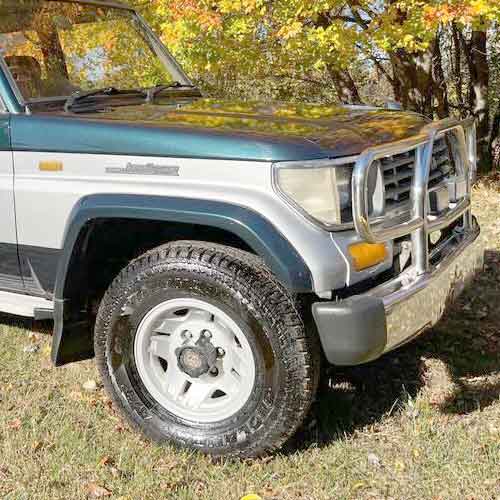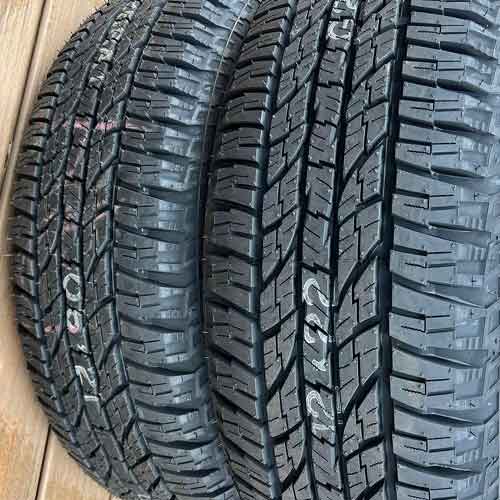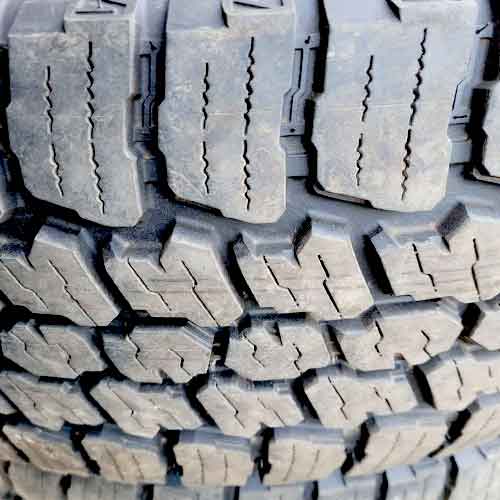Both the Sumitomo Encounter A/T and the Yokohama Geolandar AT G015 are light all-terrain tire options, designed for full sized SUVs and trucks, though that does not mean they can’t perform off-road. Their tread supply enough biters to keep them going on rocks, dirt and even a little bit of mud. Though they work differently, lets see why!

Being a tire engineer, from my perspective, Japanese Sumitomo Encounter AT features great traction on road, where it shines the most on wet tracks, and offers longer lasting tread. Yokohama G015 on the other side, gives you the top-tier comfortability on road and a very sound-proof ride, and off road, it’s slightly superior there as well, on all, well, except for sand.
Detailed Review of Sumitomo A/T: https://tiredriver.com/sumitomo-encounter-at-all-terrain-review/
Detailed Review of Yokohama A/T G015: https://tiredriver.com/yokohama-geolandar-g015-review/
Tire Sizes
Let’s start with Yokohama Geolandar AT sizes. It comes in 15 to 22 inches with following specs.
- Load Ratings: SL, XL, C, D and E.
- Weight range: 25 to 70 lbs.
- Speed ratings: R, S, T, and H.
- Tread depth range: 12/32″ to 18/32″.
- Warranty: 60k for P metric and 50k for LT sizes.
On the flip side, the Sumitomo Encounter AT comes in 15 to 20 inches (wheel diameter).
And they have following specs.
- Load ratings: SL, XL, C, D, and E.
- Weight range: 34 to 84 lbs.
- Speed rating are available in Q, R, S and T.
- Tread depth varies form 13 to 20/32″.
- Warranty: 60k for all sizes.
Tread Pattern
The Yokohama Geolandar A/T tire has a tread pattern with numerous biting edges everywhere. Lets start things off from the middle.

The tread makes 3 ribs here, where the center most is slightly narrower, and the outer two ribs are thicker and have both lateral and longitudinal “in-groove” notches, (where in the middle there’s only lateral).
All these lugs also carry full depth (very small) interlocking siping as well.
Moving towards sides…
The shoulder lugs on the inner margins, have full depth notches and wave-like siping (just like seen in the middle).
And towards outer edges, they are although not staggered, they form sharp stepped edges, which helps with off-road chewing.
And yes, worth reminding, all these ribs, including shoulders have secondary layers running underneath. Meaning, they may look like they form proper blocks, they don’t split down all the way, as they are joined together to each other (in those lateral grooves).
Let’s look at the other tire. The Sumitomo Encounter A/T tire has a very similar 5 rib structure.

Here the shoulder ribs cover most of the tread’s area, as they contain bigger elongated blocks there.
They have full depth interlocking siping and off set edges.
In between these lugs, you also get to see small stone ejectors, “for the sake of it”, as they aren’t very efficient.
Moreover, all these lugs are joined together with each other with ridges placements in between (that basically deals with noise and lateral on-road stability).
Towards outer edges, they make M shaped sidewall lugs, but as for shoulder blocks, they are not staggered.
Though you can still say, each lug is staggered on itself.
The middle area of the tire is pretty straight forward, you get narrower 3 ribs here, with notches full depth “somewhat” interlocking sipes and reinforced foundational supports.
Durability
Off-road tires must be able to withstand harsh terrain and sharp objects, making durability a crucial factor.
And here, “sidewalls” are particularly more susceptible to punctures and cuts, so it’s important that they are adequately protected.
Both tires have 2 ply polyester construction, with 2 steel belts and a single ply nylon, where on Yokohama Geolandar the cap ply is spirally wound whereas on other its not.
So although both tires sidewalls are only protected form 2 ply polyester from underneath, with slightly better lugs there, things are better with Sumitomo.
Dry Performance
To properly evaluate the dry performance of an all-terrain tire, we should consider traction, steering, and cornering. Let’s examine each of these factors one by one.
Dry Grip
The Yokohama Geolandar G015 although makes a very stable design with continuous running ribs, it’s middle most rib is not as wide. And so its not able to provide as much of a directional grip with limited road contact.
Basically directional grip has to do when a tire rolls over a straight path, where most of it’s weight is focused upon the middle part of the tread, so how much that area is exposed with the road matters a lot.
The Sumitomo Encounter A/T, does better here as its offers larger foot print “from the middle”, while keeping a good balance between stiffness and softness.
Though at higher speeds it’s still not able to provide as much stability as it’s competitor. That’s why its speed ratings only go up to T, whereas on Yokohama G015 A/T you get up to H.
Dry Handling
Tire handling is dependent on the performance of the shoulders and sidewalls.
The Sumitomo Encounter AT ribs on sides take away the largest surface area on the tread, as it’s shoulder lugs are the biggest (compared to others).
All these lugs have similar tread features, and they make a better connection with the road while turning.
Yokohama G015, conversely, has shoulder lugs equipped with all sorts of biters, which eat away the rubber, that could have been in contact with the ground, so it’s not able to provide as much of a lateral traction, comparatively.
Steering Communication
Steering communication, or steering sensitivity, is an important performance metric that determines how easy it is to maneuver the tires. This is often overlooked, but can greatly impact the handling of a vehicle.
Here, the consistency of rubber to road meet up is judged. (And grooves break that connection).
And although both tires have equally wider lateral grooves, the Sumitomo Encounter AT still provides better efficacy with it’s smoother, more streamlined design with less biters, allowing firmer rubber to road meet-up.
Wet Traction
Wet performance is divided into two aspects: wet traction and hydroplaning resistance.
Out of them, although grip is slightly difficult to achieve, A/T tires do good with hydroplaning. Let’s discuss them both.
Wet Grip
Sipes are just slits/gaps in tread which have air in them and upon meeting the road, they push out that air to create suction, so water can get slurped in.
So more sipes mean better water wiping, but you also need sipe flexibility too, otherwise they won’t work effectively.
The Sumitomo Encounter AT offers dual siping design where although its interlocking in both, it’s design gets to be more aggressive on shoulders.
With this design, sipes stay soaking at all times, and the tire’s tread is already pretty elastic. So it makes sense, why this tire performs better.
On the other side, the Yokohama Geolandar A/T does not make efficient enough siping, as it’s design is basically better optimized for winter traction (as you’ll see below, in its section).
Hydroplaning
Hydroplaning can be prevented by ensuring tire has sufficient grooves to effectively evacuate water from its tread.
These grooves help the tire maintain contact with the road surface, even when moving through at higher speeds.
And looking at both tires it can used to further explain why Sumitomo does great overall with wet traction. It basically offers straight forward combination of lateral and longitudinal grooves, allowing water to escape out in all directions quickly and effectively.
The Yokohama G015 A/T on the other side, with continuous running ribs does not allow the sideways water removal, reducing overall resistance to aquaplaning, especially on curves.
Fuel Consumption
The overall rolling resistance, which gets calculated by friction a tire generates with the road, is the one in charge, that decides the overall fuel economy.
And out of both tires, the Yokohama Geolandar A/T G015 does things better with it’s lighter structural weight (comparatively).
With just one cap ply, it basically puts less weigh per lug, so it’s blocks rubs off with the surface they are on with less force.
The Sumitomo Encounter A/T on the other side, although also distributes it’s weight quite evenly on all, the higher weight still causes it to consume more fuel in comparison.
Off-Road Traction
All-terrain tires need to find a good balance between “on and off road traction”, where rugged terrains have a lot more variations.
Let’s discuss them all one by one.
On Mud
Mud is a toughest challenge of all. That’s why we have tires named after them, “mud-terrain”.
But why mud tires are better? Well, because they are balder, and mud needs to leave out fast otherwise it would pack up a tire.
That’s why with continuous running ribs, and not lateral pathways, the Yokohama Geolandar A/T does not allow efficient enough removal capabilities.
The Sumitomo A/T is also not good enough, but in comparison, it does provide a much better self cleaning tread, where it’s open shoulder lugs are also embedded with stone ejectors.
On Rocks
On rocks, or should I say climbing big rocks, you need biters + durability (of sidewalls, for the most part).
Now out of two, both have 2 ply sides, though with thicker “M” shaped lugs, the Sumitomo A/T not only provides slightly better durability, it’s also gets to enhance its footprint in a better way with lowered air pressure.
The Yokohama A/T on the other side is only better with directional grip, as it’s softer lugs combined with uncountable biters (in the middle), create better gripping capabilities.
Though it could really use some sideways traction.
On Sand
Although the Sumitomo Encounter AT is heavier (going up to 80+ pounds in weight), it’s closed up lugs, and sidewall pattern allows it to float better with lowered pressure.
Yokohama Geolandar A/T G015 again with missing sidewalls is not able to provide better footprint, nor it’s sharp sides prevent it from digging, so it lacks here overall.
(Digging is the worst enemy of sand traction, that’s why we have balloon tires for this type of terrain).
Tread Life
Tread longevity depends on rolling resistance, the elasticity of the tread and depth of voids.
That’s why Sumitomo Encounter AT having tread depth (reaching up to ) 20/32″ takes much longer time to completely wear off.
The Yokohama Geolandar A/T G015 in comparison, yields a faster wearing rate with it’s softer composition, and here it’s tread depth is also not helping it as it only reaches up to 18/32″ (though its pretty good compared to all-terrain options).
Tread Noise
Off road tires produce more noise compared to passenger tires, that’s because they are more voided.
With balder design, air particles basically strike around more freely, and this is what causes “tread noise”.
Though still out of both, less noise gets generated on Yokohama Geolandar A/T, due to it’s more packed up design.
But don’t get me wrong, the The Sumitomo Encounter AT is still pretty great as well, but it only lacks with such high tread depth reaching up to 20/32″, so air has more gap to move around.
And so it’s tread voids have more groove resonance.
Though same tread depth, is ironically helping this tire in overall comfort, as it’s thick rubber is able to settle down the vibrations of the road.
Winter Performance
As you folks can tell by now, both tires are pretty soft, this allows them to bear the extreme negative temperatures to a good extent.
So with this, their rubber remains flexible and their tread don’t become a brick, allowing sipes to have better stretchability.
That’s why both tires have sever snow grades of 3 Peak Mountain Snowflake and M+S ratings.
But still out of them with more biters, the Yokohama G015 offers slightly better results.
Winding Up
Yokohama Geolandar A/T G015 is one of the best tires to have (in all-terrain tires) when it comes to comfort and on road noise. The tire offers amazing ride quality values.
Though traction wise, the Sumitomo A/T takes the cherry.
And off-road there are some pretty mixed up results, though I can tell you that Encounter A/T offers better self cleaning tread out of these two tires.